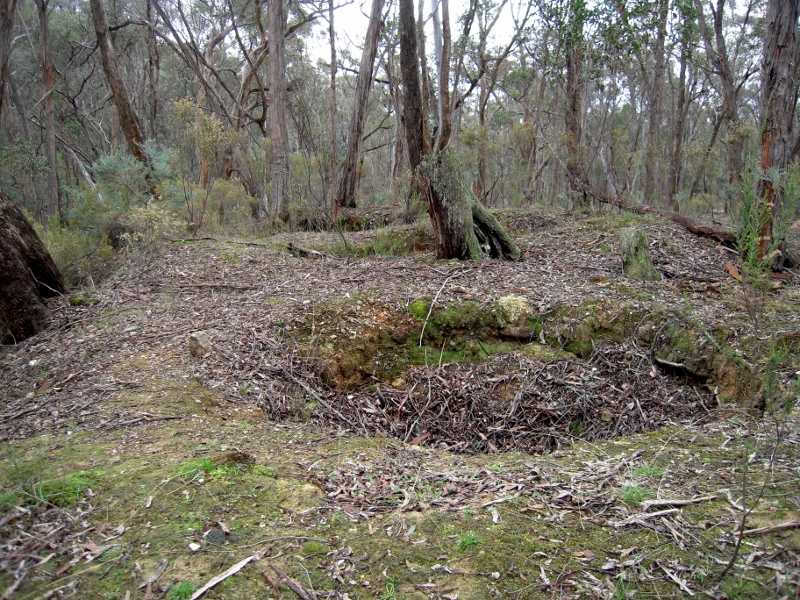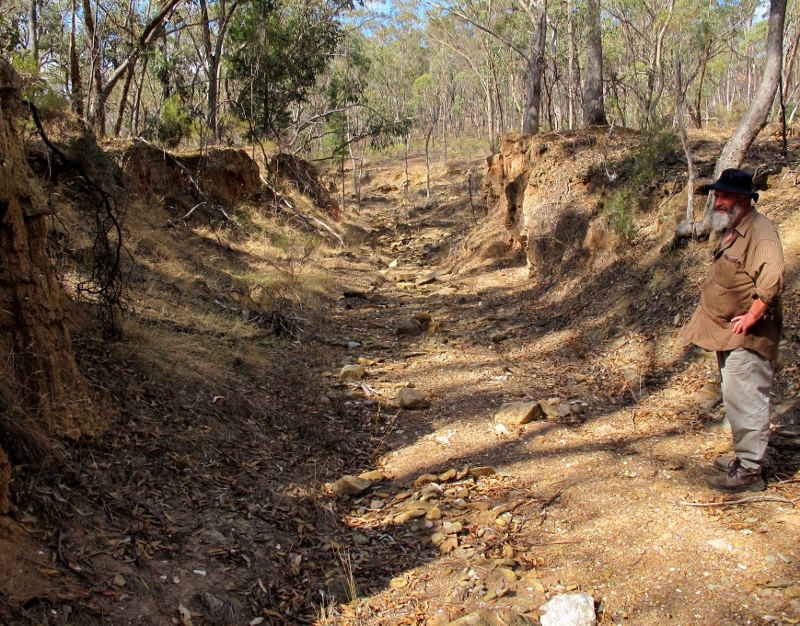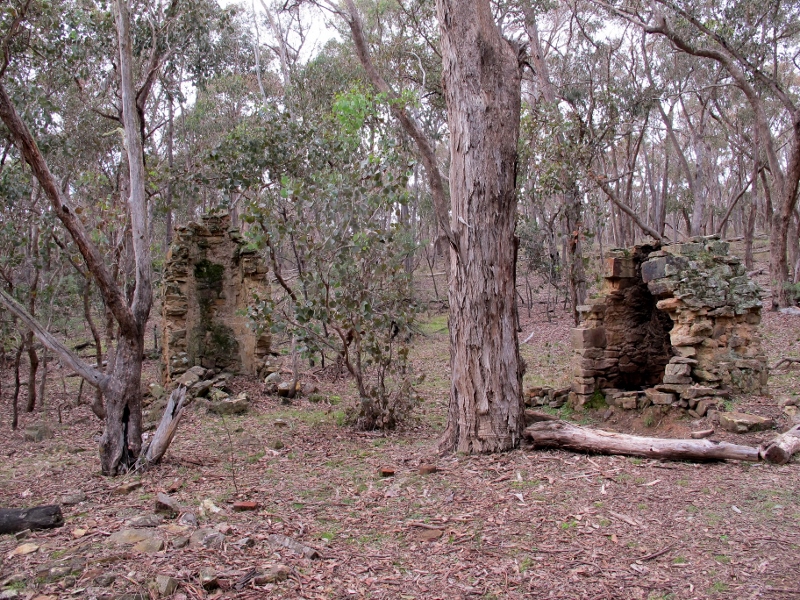What is a heritage landscape, and what difference does the tag ‘heritage’ make to the way a landscape should be managed?
Of course, all landscapes are ‘heritage’ or ‘cultural’ landscapes in one way or another: but there’s only one in Australia which has protected dual National Park/Heritage Park status, and that’s the Castlemaine Diggings.
That’s why we were disappointed in the VEAC Historic Places Investigation Draft Proposals Paper. This paper explicitly adopted a limited meaning for the phrase ‘heritage place’, one that seemed to exclude ‘landscape’ from consideration.
FOBIF has submitted a response to the Draft. It is set out below.
************************
Although we believe there are many constructive and sensible proposals in this paper, we wish to focus on what we believe to be a serious—and strange—deficiency: that is, the failure to acknowledge the particular challenges presented by cultural landscapes. In fact, it appears that the authors of the paper do not believe that these landscapes are ‘historic places’ at all, as witness this passage on page 31:
‘It is important to note that although VEAC’s focus is on the management of specific places on public land, Traditional Owners customarily have a broader view that every part of the landscape is of significance, including landforms and the whole landscape itself, not only those places where associations are evident or documented.’

Shallow shafts being reclaimed by nature, Sebastopol Creek: how is the bushland setting to be interpreted in the National Heritage Park?
We are not suggesting that our cultural landscapes can be considered in the same way that Indigenous people look at country: but the concession made in the above paragraph essentially concedes that VEAC has not considered ‘landscape’ at all in this draft.
We can’t see the reason for this exclusion: after all, on page 4 of the draft we read that ‘historic places’ include ‘historic sites or areas’. What is a landscape if it’s not an ‘area’? And in Appendix 2 [Historic groups or typology] we find Landscape area: natural and cultural historic landscapes. Other group categories in this Appendix are given numerous examples, but for some reason Landscape area has only one: Tower Hill.
There are significant areas of Victoria which are landscapes on the state and national heritage list: the Grampians/Gariwerd, the Alps, and the Castlemaine Diggings National Heritage Park. We therefore find it puzzling that the draft paper has failed to consider the peculiar challenges presented to managers of these areas.
In fact, it seems that the authors of the paper would prefer to ignore the landscapes as entities and consider them to be collections of distinct places: the Alps, for example, has historic huts; Castlemaine Diggings has mining ruins. As far as management is concerned, these places could therefore be considered in the same way as a historic building in the city of Melbourne—in theory, at least.
This view seems confirmed—and it looks like it’s a view shared by Parks Victoria—by the reference on page 37 to Parks Victoria’s $200,000 budget to manage ‘some 3000 historic sites’. We note in passing that for practical purposes Parks Victoria’s 2003 Heritage Management Strategy appears to have been written as if the Castlemaine Diggings National Heritage Park did not exist as a heritage landscape: a strange fact, since the excellent Heritage Action Plan for the Park had been published in 2002.]
We believe it is vital to the proper understanding and management of these places that they are first acknowledged to be landscapes—and contested landscapes at that. To fail to do that is to refuse to see the most striking things about them.
Castlemaine Diggings is described by Parks Victoria as ‘the largest non-indigenous protected cultural landscape in Australia.’ Its National Heritage listing, bland though it is, offers this: ‘Situated within regenerating box-ironbark forest, the mining remains and habitation sites immediately convey to the visitor a feeling of passed [sic] ways of working and living. The great number and extent of remains reinforces to the visitor the historical significance of the goldfield. The degree of alteration of, and intervention in, the natural landscape makes a strong impression on visitors. The Castlemaine diggings are a place of strong aesthetic significance. The attributes include the wide expanses of regenerating box-ironbark forest, the landforms of hills, ridges, gullies, creeks and rivers, together with the multitude of mining and habitation remains…’ The Victorian Heritage listing says: ‘The land and its regenerating Box-Ironbark forest is important scientific evidence in its own right in demonstrating a spectacular event of transformation of the pre-gold rush environment.’

The late Doug Ralph surveying old and new watercourse damage, Castlemaine Diggings NHP, 2013. This is heritage too–but how should it be presented to the public?
All these formulations speak, not of collections of relics, but of a transformative drama over a whole landscape. Looking at the historical themes as laid out in Appendix 3 of the draft, we would assert that the Diggings Park is as notable for the theme 4.7 ‘transforming the land and its waterways’ as it is for 4.5 ‘gold mining.’
The failure to acknowledge landscape as a heritage fact leaves a disturbing vacuum in the paper. In its brief discussion of Aboriginal heritage the draft correctly laments the failure to communicate the ‘layers of experience at sites that are rich with Aboriginal heritage.’ [page 31] A similar failure is inevitable when landscape is ignored as ‘heritage place’: the need to understand the layers in the landscape of the goldfields—what it was like before the gold rushes, during their heyday, and the land’s long, partial recovery since—disappears when visitors are encouraged only to focus on methods of mining, and the social realities it revealed.
There are serious implications here for the way this particular heritage place is managed and promoted. For example, the Park’s management [2005] plan envisages that over the years the park will carry a ‘more appropriate balance of juvenile, intermediate and mature trees’—in other words, that it might return to something more like a pre 1852 landscape. Given that fire practices over the last 10 years have tended to destroy large numbers of mature trees, you might say that such practices have heritage as well as environmental implications. The Environment Protection and Biodiversity Conservation Act requires that any action significantly affecting areas listed as national heritage needs ‘prior approval’: we suspect that approval for fire activity in the Park has only been sought in connection with goldfields ruins, and that no consideration has been taken for the landscape impacts of such activity.
Is ‘heritage’ just a nice lot of old stuff we can look at and be nostalgic about? Or is it something more challenging? The 2014 Parliamentary enquiry into Heritage and Ecotourism quoted the National Trust, as follows: ‘The existence of heritage, its protection and its connection with the community does not guarantee that it will attract tourists. A sanitised heritage presenting a safe interpretation of history and culture holds little appeal and will not generate interest amongst tourists.’

Hunt’s huts, Brown’s Gully, Castlemaine Diggings NHP: ‘150 years later the landscape has mellowed and taken on a new cultural identity that awaits deciphering by the discerning tourist. How will this be done? How can the landscape speak for itself?’
We support many of the draft recommendations in the report, especially those relating to transparency, accountability and minimum standards. Not one of these recommendations, however, applies directly to heritage landscape: nor is it clear how they could be phrased to make them applicable in that way.
We propose that, in order to clarify VEAC’s position on heritage landscapes, the draft be altered to include:
- A specific reference to heritage landscape and the management challenges it incurs
- An extra boxed story centred on the Diggings Park [or the Alps, or the Grampians] illustrating the point made
- A request for clarity in the Parks Victoria budget as to what funds are allocated to management of its heritage landscapes, and how these funds have fluctuated over the years
- A request for clarity from Parks Victoria and DELWP as to how a protected heritage status affects its management of roads and tracks, fuel reduction operations and weed control
- A recommendation specifically concerned with interpretation of heritage places, which would contain material specifically concerned with landscapes. Themes that might be included:
- ‘The World Heritage Bureau has recommended greater recognition of the continuum of, and interactions between, culture and nature with respect to the implementation of the World Heritage Convention’ (Castlemaine Diggings HAP, Appendix C page 3).
- The Operational Guidelines for the Implementation of the World Heritage Convention (1999) note:‘Cultural landscapes are illustrative of the evolution of human society and settlement over time, under the influence of the physical constraints and/or opportunities presented by their natural environment and of successive social, economic and cultural forces, both internal and external.’ (paragraph 36)
- ‘Interpretation of the gold rush era has tended to focus on the heydays of the 1850s yet the traces of that era that we see in the landscape to-day are not the same as the rapid environmental chaos that followed then—150 years later the landscape has mellowed and taken on a new cultural identity that awaits deciphering by the discerning tourist. How will this be done? How can the landscape speak for itself?’ (Jane Lennon: Historic Environment VII 1 1989 page 28)




 Click on image for info/order page
Click on image for info/order page Click on image for info/order page
Click on image for info/order page Click on image for info/order page
Click on image for info/order page





















